Most Read in This Section
-
Nov. 5, 2024
-
-
-
Nov. 5, 2024
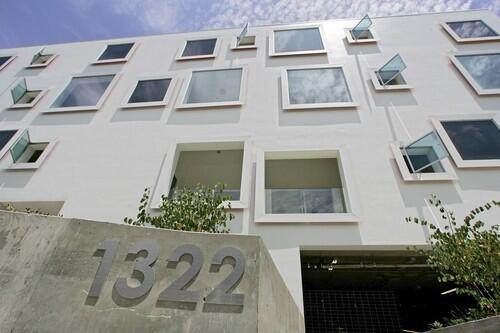
By David Hay
Habitat 15, a new town house complex on Detroit Street in Los Angeles, has 27 windows of differing sizes, all placed in a seemingly random pattern across the 80-foot-long front facade. The effect is akin to a giant wall of flat-panel TVs, and according to Santa Monica architects Hadrian Predock and John Frane, the facade pays homage to the world of movies. “The building is in Hollywood after all,” Predock said. (Ricardo DeAratanha / Los Angeles Times)
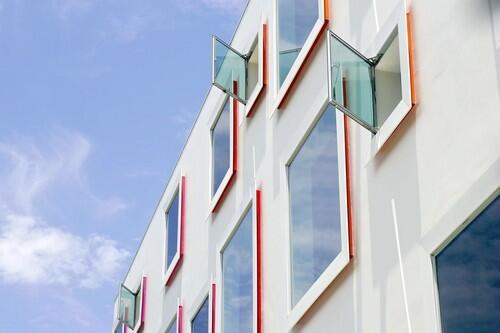
The glass panes have been pushed out 6 inches and the backs of their frames have been painted a variety of hues, so as the sun rises, the four-story stucco building glows with soft, shifting color. (Ricardo DeAratanha / Los Angeles Times)
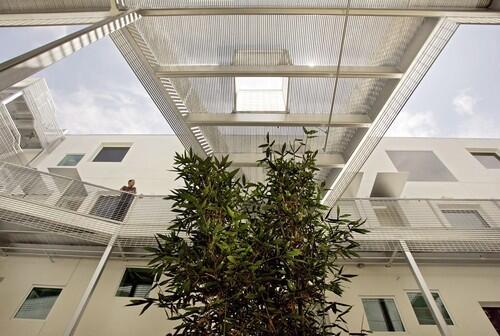
Habitat 15 symbolizes something much larger than an homage to movies. It represents a city in transition. As the region grows denser, architects and developers continue to look for ways to create new types of living arrangements in this case, a clever complex that uses the citys town home ordinance to squeeze 15 residences onto a 14,000-square-foot lot. Here, one of the architectural features: a courtyard crisscrossed by steel bridges. (Ricardo DeAratanha / Los Angeles Times)
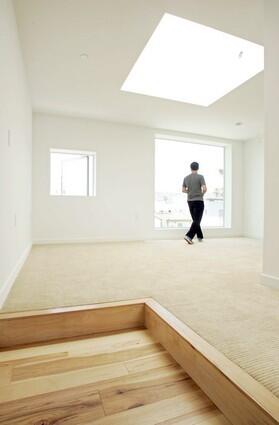
Hadrian Predock stands by one of the windows that gives the project its striking presence on the street. Design elements such as the irregular window placement are not merely an artistic statement. Their positioning on walls, as well as on the roof in the form of skylights, is driven less by the aesthetic demands for symmetry and more by the need to draw light inside the homes, some of which are two stories tall, some of which are three. Lucky for the architects, the final result is functional and idiosyncratically arresting. (Ricardo DeAratanha / Los Angeles Times)
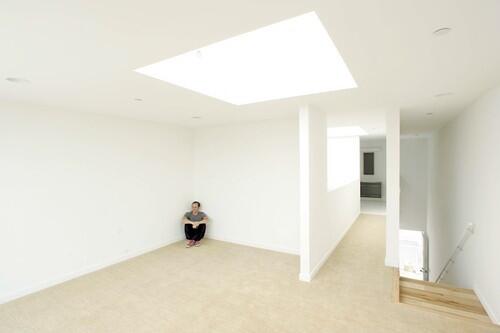
The reverse view, with Predock sitting in the corner. The development, scheduled for completion later this summer, is meant to appeal to young professionals who are eager to step up from apartment living but cannot afford most traditional single-family houses on the Westside. The idea behind the compact urban dwellings is to create homes that are unique and that feel more like individual houses than cookie-cutter condos stacked atop one another. In designing the living spaces, Predock and Frane were given considerable freedom by developer Richard Loring, president of the Habitat Group. (Ricardo DeAratanha / Los Angeles Times)
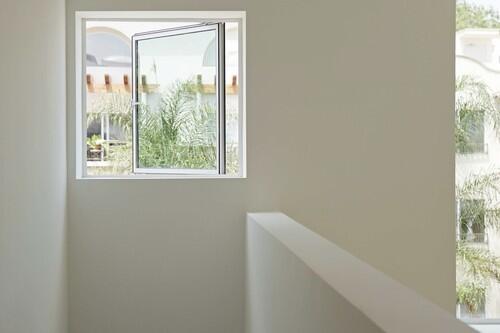
Windows deliver natural light, fresh air and in some cases, a view. Most of the town houses have a loft-like, open bedroom, usually on a floor separate from the main living area. A second bedroom, more private and smaller, could be an office, guest room or home for a roommate, Predock said. (Ricardo DeAratanha / Los Angeles Times)
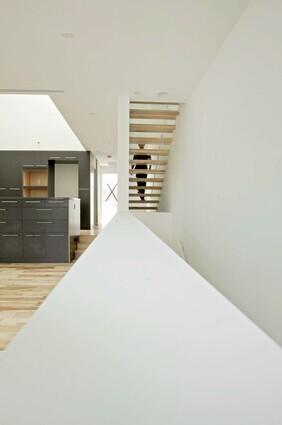
The town houses are an average of 17 feet wide and 40 feet deep, but a sense of spaciousness is afforded by the height of their ceilings: 10 feet high on the first floor, as high as 20 feet in other areas. Skylights and the multistory design also help. Psychologically, there is more sense of space when youre going up and down between levels, Frane said. Three-story units have skylights strategically placed to allow the suns rays to reach all levels. This layering of light is particularly critical to the homes in the buildings middle sections, which dont get as much daylight from side windows as in units at the buildings corners. (Ricardo DeAratanha / Los Angeles Times)
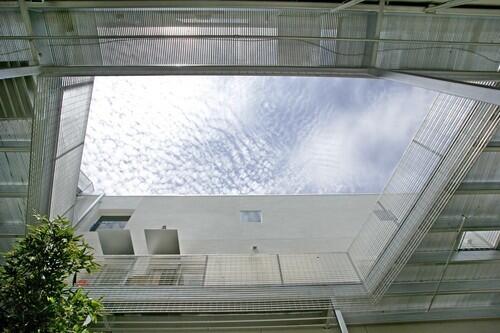
The architects ultimately built two separate elongated blocks with a multileveled courtyard in between. Intent on privacy for each unit, Predock and Frane avoided the pitfall of many complexes, which often place the pool in the center space. They are noisy, and often end up making residents feel like theyre living in each others apartments, Predock said. (Ricardo DeAratanha / Los Angeles Times)
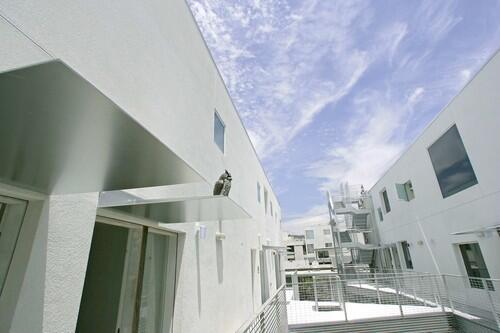
The courtyard at Habitat 15 is crisscrossed by large steel stairways and spanned by two steel bridges. The building has one elevator, on the western row of units, so residents of the eastern structure cross the center bridge to reach home. (Ricardo DeAratanha / Los Angeles Times)
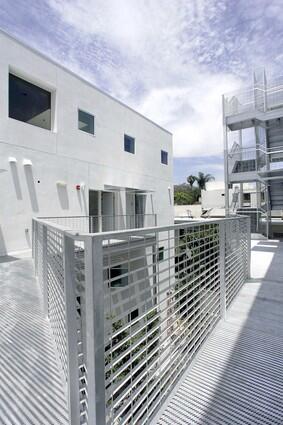
The architects didnt want homeowners opening their front doors and having neighbors looking in from across the courtyard. So they placed 40-foot-high steel poles, 25 of them in all, in a straight line along the courtyard a construction they call a pergola, on which vines eventually will grow to form a green wall. (Ricardo DeAratanha / Los Angeles Times)

One of the skylights sends shafts of light through multiple floors of the town house units below. (Ricardo DeAratanha / Los Angeles Times)
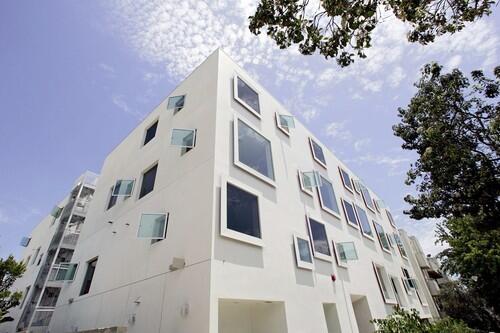
Richard Loring, whose developments include the Lorcan OHerlihy-designed complex next to the landmark Schindler House in West Hollywood, said he thought the Detroit Street complex raises the bar for design in the area while filling a long-overlooked niche in the market. When Habitat 15 goes on sale this summer, prices will range from $590,000 to $849,000. Loring said he expected them to sell in three to four months. Whether that prediction proves correct may provide some hint as to how many more ambitious designs may or may not be headed our way in the years to come.
For a peek inside more residential designs, check out our Homes of The Times gallery. We also have a string of links from L.A. at Home, our home and garden blog. (Ricardo DeAratanha / Los Angeles Times)
Nov. 5, 2024
Nov. 5, 2024